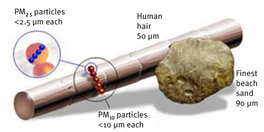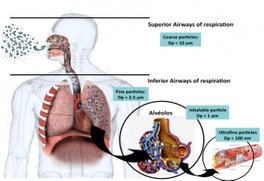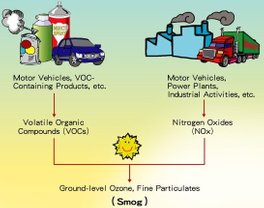FogLamp cleans the air !
Air pollution is one of the several environmental factors that is having a serious impact on human health and quality of life. Particulate matter (PM) air pollution, measuring less than 2.5 μm, has been the focus of international concern due to its diverse contribution to the global burden of disease. There have been more than 2,000 peer-reviewed studies published since 1997 linking it to strokes, various respiratory and cardiovascular problems and premature death. Unfortunately, the majority of the planet still resides in areas where the World Health Organization Air Quality Guidelines of 10 μg/m3 (annual) and 25 μg/m3 (24-hour period) is exceeded.
Global estimates of ambient pollution levels have relied heavily upon either econometric or transport models mostly due to the lack of ground-level measurements of air pollution, especially PM2.5, which have been unavailable for most of the planet.
Yet, the distinctive nature of the emission source and the atmospheric and weather conditions has been found to either reduce or exacerbate the effects of PM2.5. Studies are needed to evaluate and provide insight in high-risk areas as to the exposure and risk as many of the forms of air pollution are beyond the control of individuals and require policy at the national and international levels.
Developing countries, such as Brazil have several factors that are contributing to rising levels of PM2.5 and the increasing respiratory morbidity and mortality rates in certain regions, most notably in the Brazilian Amazon. In the last 20 years, Brazil has had drastic changes in its land use, specifically in the Amazon region, where conversion of forests to pastures represents a long-term emission source of biomass burning for the region. Another important source of biomass burning that is significantly rising is from sugarcane production in the surrounding areas, caused by the expansion of the clean fuel industry.
Currently, Brazil is the largest world producer and exporter of alcohol. However 75% of sugarcane harvesting in Brazil is done manually and utilizes pre-harvest burning. In the Amazon region the sugarcane harvest occurs between April and October during the months of low precipitation when fires substantially deteriorate the air quality in the surrounding areas. An area referred to as the “arc of deforestation” resting within the Amazon region is known for its intense biomass burning and is the source of the increasing levels of air pollution in the Amazon ecosystem. These areas have reached PM2.5 levels of up to 350–450 μg/m3. These levels of PM2.5 have been detected also in China, Thailand, ... and are considered responsable of serius problem like cancer, stoke, asthma and not only.
In terms of morbidity and mortality, most epidemiological studies indicate that there is no PM2.5 threshold concentration that does not cause negative health effects and even minor exposure is known to pose an additional risk to those with existing heart, respiratory or other chronic diseases. The resulting effects of these pollutant levels have serious implications on the more than 22 million people living in the PM2.5 polluted region, especially the more vulnerable population subgroups such as children and the elderly.
PM2.5 is also known as smog or silent killer and it is generated by human activities, it is not normal and our bodies have no defense against it. PM2.5 never ever existed in nature before the industrialization around the year 1900.
Recent epidemiological studies have suggested a link between exposure to ambient air-pollution and susceptibility to metabolic disorders such as Type II diabetes mellitus, Alzheimer, senile demenz, infart, . Previously, we provided evidence that both short- and long-term exposure to concentrated ambient particulate matter with aerodynamic diameter <2.5 μm (PM2.5) induces multiple abnormalities associated with the pathogenesis of Type II diabetes mellitus, including insulin resistance, visceral adipose inflammation, brown adipose mitochondrial adipose changes, and hepatic endoplasmic reticulum (ER) stress. In this report, we show that chronic inhalation exposure to PM2.5 (10 months exposure) induces macrophage infiltration and Unfolded Protein Response (UPR), an intracellular stress signaling that regulates cell metabolism and survival, in mouse white adipose tissue in vivo. Gene expression studies suggested that PM2.5 exposure induces two distinct UPR signaling pathways mediated through the UPR transducer inositol-requiring 1α (IRE1α): 1) ER-associated Degradation (ERAD) of unfolded or misfolded proteins, and 2) Regulated IRE1-dependent Decay (RIDD) of mRNAs. Along with the induction of the UPR pathways and macrophage infiltration, expression of genes involved in lipogenesis, adipocyte differentiation, and lipid droplet formation was increased in the adipose tissue of the mice exposed to PM2.5. In vitro study confirmed that PM2.5 can trigger phosphorylation of the UPR transducer IRE1α and activation of macrophages. These results provide novel insights into PM2.5-triggered cell stress response in adipose tissue and increase our understanding of pathophysiological effects of particulate air pollution on the development of metabolic disorders.
Copyright © 2018 TSHSE S.A. All Rights Reserved


